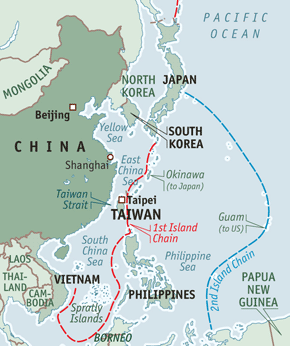Against Bluster, China and North Korea Hold the Hot Hands
Apr 22 2017Fearful that economic collapse would bring a flood of refugees, China has for decades been North Korea's principal source of support, which we covered in "North Korea Threat of War Heightens, As U.S. Options Diminish". China's view is that America's aggressive posture — troops stationed in South Korea for the 64 years since the Korean War ended, joint military exercises the U.S. conducts with the South — forced Pyongyang to develop nuclear weapons in defense of its existence. China wants the U.S. to resume the six-party talks that ended in 2009 when the North Koreans walked out and expelled all nuclear inspectors from the country. They advise that we take steps to make the North Koreans and their volatile ruler feel more secure. Secretary of State Rex Tillerson said in March that the U.S. would not engage in talks unless North Korea first abandon both its missile and nuclear programs. That bossy stance — and pre-conditions in general — was a mindless guarantee that there will be no talks.
Instead, Trump has opted for bellicosity by sending an "armada" — Trump's word — led by the carrier USS Carl Vinson to take up station along the North Korean coast, a standard U.S. show-of-force maneuver lacking in any indication of what it can accomplish against missiles and nuclear facilities in impenetrable caves, and missiles that are now solid-fueled and free to roam. But the carrier group does include Aegis cruisers with anti-missile weaponry. Possibly the plan is an attempted shoot down of ICBM tests. That is, once the armada gets there. Last seen, it was headed for Australia.
On the first day of his 10-day swing through the Far East, Vice President Mike Pence went to South Korea to assure the country of U.S. support, and to the edge of the Demiltarized Zone between the two Koreas for a photo-op. He looked across sternly at DPRK (Democratic People's Republic of Korea) troops snapping photos of him, while at home the President, strolling the White House lawn amid the traditional Easter egg roll, said Pyongyang "gotta behave". Pence grandly decreed what the DPRK absolutely will not do.
"President Trump has made it clear that the patience of the United States and our allies in this region has run out and we want to see change. We want to see North Korea abandon its reckless path of the development of nuclear weapons, and also its continual use and testing of ballistic missiles is unacceptable."
China accounts for 90% of North Korea's trading with the outside world. The U.S. has urged China to cut the lifeline as the strongest way to bring North Korea to heel. China's only gesture has been to end importing coal from North Korea, a commodity that has been a major provider of hard currency for Pyongyang. This is no hardship for China; they can get coal elsewhere. More indicative of their indifference to Kim's threats against the U.S. is that China just announced that the trade that supports the North ran 37% higher in the first quarter compared to a year ago. A network of some 600 Chinese companies keeps the northern dynasty in power, providing both goods and 40% of the currency it needs to trade with the world beyond.
Which is to say that China has not been helpful. It protested when the U.S. installed its THAAD anti-missile system in South Korea. Far from accommodating the South's need for protection from the lunacy of Kim's threats to turn Seoul into a "sea of fire — the capital is only 35 miles from the border — China cancelled contracts with prominent South Korean companies in retaliation. Their concern is that THAAD's radar could penetrate the border and spy on whatever China is up to. This latest flare-up could not have occurred at a more insecure moment for South Korea, which just impeached and removed its president on corruption charges and awaits an election for her replacement in May. It is extremely anxious that the headstrong Mr. Trump might initiate some action without first gaining the South's consent.
trading placesWhen Trump says after his meeting with Xi that, "We have a very good relationship. We have great chemistry together. We like each other", thoughts return to G. W. Bush thinking he saw into Vladimir Putin's soul. This is the same Xi Jinping who — playing on world alarm at America's choice of Donald Trump — gave a "well-received" speech at the annual gathering of world potentates in Davos, Switzerland, in which he made the case that China should now be the power to "guide economic globalization", not the U.S. He lectured America that it was walking into the "Thucydides trap" that befell the Spartans for their failure to accommodate the rising power of the Athenians.
Kim Jong-un's claim of last year that one of North Korea's underground tests was of a hydrogen bomb was met with international skepticism, but recently an online ad offering 22 pounds of lithium 6 for sale every month by North Korea's third secretary at its embassy in Beijing was an eye-opener for intelligence networks. For the North to have an excess of lithium 6, which can boost an atom bomb into a hydrogen bomb, "magnifying its destructive power by up to 1,000 times", says they are at work on a hydrogen weapon. There was concern that Kim would order the sixth nuclear test to coincide with the mid-April celebration of the 105th anniversary of the birth of Kim Il-sung, the country’s founder. Instead, on the morning after caissons bearing the country's repertoire of missiles rolled by on parade, North Korea launched yet another ballistic missile. It exploded just after liftoff, leading to renewed speculation that the U.S. may have infiltrated the North's systems with malware as the cause of so many failures. But few doubt that Mr. Kim's engineers will achieve the objective of a missile capable of reaching the West Coast of the United States.
islands in the seaChina has built out 3000 acres on rocks and reefs in the South China Sea. The rights to all are contested by other bordering countries, but China claims those it wants, even when hundreds of miles from China's coastline and close to a rival country. A short time ago it had enough manufactured real estate to lay down airstrips capable of handling the largest aircraft. Now, three of the islands have room enough for fighter bases comparable in size to those on the mainland and for the 17,000 personnel of an entire fighter division. With President Obama at his side at the White House in September 2015, President Xi had said "China does not intend to pursue militarization" of the artificial islands, a promise broken by the recent installation of anti-aircraft batteries. They are "primarily for defense and protection, and this is proper and legitimate", states the website of the Defense Ministry. "If someone was at the door of your home, cocky and swaggering" — that would be the U.S. merely sailing by, patrolling international waters — "how could it be that you wouldn't prepare a slingshot?".
"We're going to have to send China a clear signal that, first, the island building stops. And second, your access to those islands also is not going to be allowed."
Rex Tillerson said that in January during his confirmation hearing. Apart from how that manifesto could be enforced other than by war, how do we enlist China's aid against North Korea with that ill-considered provocation still aloft in the sea breezes?
China is building its navy, which it has not done for 600 years. Its ships have begun to roam far from home. There are anguished voices in America that decry how we have allowed our navy to shrink to so few ships. Others call them captives of history who imagine a bygone world in which the outcome of a war could turn on set piece ship-against-ship battles.
This is an age of technology in which a shower of the low-cost missiles that China has been developing could send one of our Nimitz class nuclear carriers to the bottom with its 5,000 souls on board and its 90-or-so planes. The Chinese have concentrated on long-range anti-ship missiles. By 2010, a Chinese program to pack conventional explosives into a nuclear ballistic missile, converting it into a carrier-killer that would descend from space at hypersonic speed, had reached “initial operational capability”. Other anti-ship missiles can be delivered from aircraft, guided-missile destroyers, fast patrol boats and submarines. We have known for five years of China's building an anti-ship ballistic missile base in southern China’s Guangdong Province from which its missiles are capable of reaching the Philippines and Vietnam.
Our navy, which for decades has performed the service of maintaining the safety of these shipping lanes through which pass half the world's cargo tonnage and 80% of the oil destined for China, is now told in a number of confrontations to "leave immediately", that our passage through these waters is "provocative behavior". That unless America stopped objecting to the island-building, war would be “inevitable”. And in the grip of China, 
dependent on them as we are for stemming the North Korean threat, conceding that the South China Sea is to become a Chinese lake is what we might have to do.
Appropriation of the islets and reefs and the equally artificial surrounding economic zones of the South China Sea is only the beginning. With its rapid naval build-up, China intends to project its power ever outward. Successive lines on their planning maps embrace successive island chains as shown on this map, such that ultimately the intention is to dominate well into the Pacific Ocean — as far as America's Guam in the 2nd Island Chain, and then beyond this map to a 3rd Island Chain where the United States currently has unchallenged naval supremacy. The final chain begins with America's and Russia's Aleutian Islands; in unofficial Chinese military literature the line extends southward to include the Hawaiian Islands.
Please subscribe if you haven't, or post a comment below about this article, or
click here to go to our front page.

